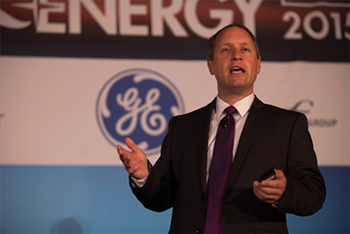Future of Propulsion and Power is Lighter, Cooler, Faster and Global Written 27 July 2015
Speaker: Christopher “Chris” Lorence, GE Aviation
By Duane Hyland, AIAA Communications (2008-2017)

Christopher “Chris” Lorence, general manager of engineering technologies with GE Aviation, kicked off the 2015 AIAA Propulsion and Energy Forum in Orlando, Florida, with a talk on the future of propulsion and energy systems. Lorence believes that eventually propulsion and energy systems on aircraft will be largely indistinguishable, bringing “the fields of propulsion and energy creation together.”
Lorence told the near-capacity crowd that “energy is an increasingly important part of what we see happening in propulsion,” explaining that the engine is the hub of everything on an aircraft, “be it a directed energy weapon on a military aircraft or charging an iPhone at your seat,” the energy comes from the engine.
Lorence reviewed several mega trends that are influencing the propulsion and energy industries, including “greater use of digital analytics, advanced composites and moving to all-electric aircraft.” Lorence explained that what drives these trends is a desire to produce engines capable of powering aircraft longer, more cheaply and with greater range than ever before.
Lorence explained that the use of digital analytics allows engineers to extract more data from the engine system, leading to a better understanding of fuel burn and capacity and ultimately allowing for a dramatic shift in thought about in-flight performance. Advanced components, such as ceramic matrix components, allow the construction of lighter, cooler and faster operating systems, lowering fuel burn by 5 percent, Lorence said, while increasing performance speed and range. Evolving to all-electric aircraft, he said, will allow for a greater variety of aircraft body shapes and a lessened impact on the environment and represent a “tremendous opportunity” for future growth in systems development.
Lorence cautioned, however, that when it comes to electric engines, “we aren’t there yet, and we still need to do more to work on fuel burn and improve performance of the engines,” but he was confident that this would happen and we will see an all-electric future.
Other trends Lorence mentioned include additive manufacturing, the development of “extreme machines” and digital technology.
Lorence concluded his talk with some of the things GE is doing to revolutionize engineering, including the formation of lean labs, or small laboratories focusing on one particular problem; renewed university partnerships, which allow students and professors to work on problems facing the aviation community; and crowdsourcing, or setting up engineering problems as competitions to allow thousands of engineers around the world to have a hand in solving them.
Lorence closed by reminding the audience that aviation makes the world smaller and brings the world together and that the future of advances in energy and propulsion systems would make that even easier for the community.
